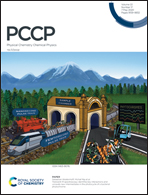Temperature-cycle electron paramagnetic resonance†
Abstract
We report on a novel approach to the study of rates and short-lived intermediates of (bio)chemical reactions that involve paramagnetic species. Temperature-cycle Electron Paramagnetic Resonance (EPR) concerns the repeated heating of a reaction mixture in the cavity of an EPR spectrometer by pulsed irradiation with a near-infrared diode laser combined with intermittent characterization of the sample by 275 GHz EPR at a lower temperature at which the reaction does not proceed. The new technique is demonstrated for the reduction of TEMPOL with sodium dithionite in aqueous solution down to the sub-second time scale. We show that a single sample suffices to obtain a complete kinetic trace. Variation of the length and power of the laser pulse offers great flexibility as regards the time scale of the experiment and the temperature at which the reaction can be studied. For water/glycerol mixtures we introduce a simple way to obtain and load an unreacted sample into the spectrometer at low temperature.



 Please wait while we load your content...
Please wait while we load your content...